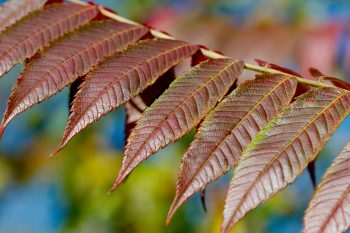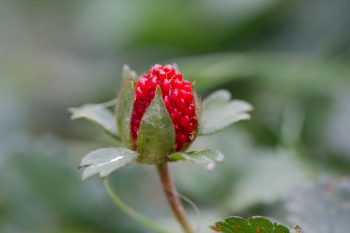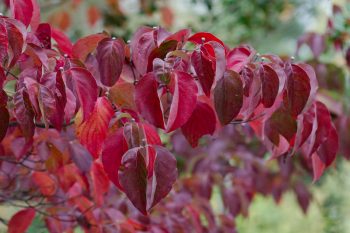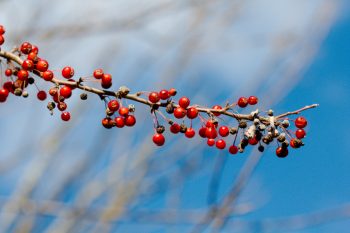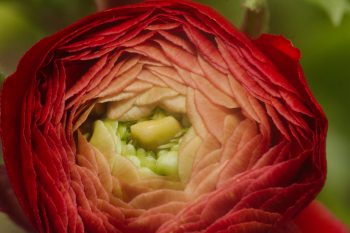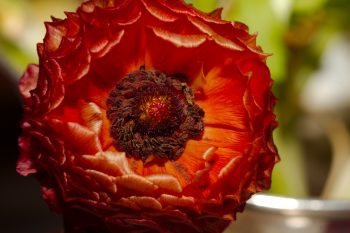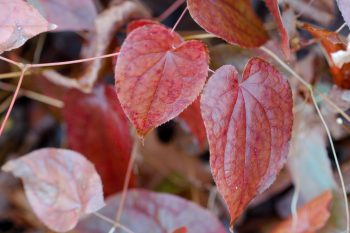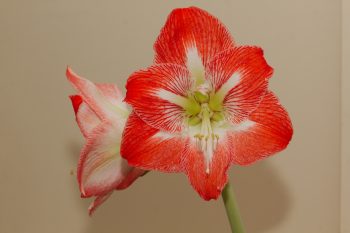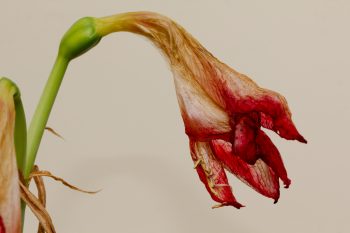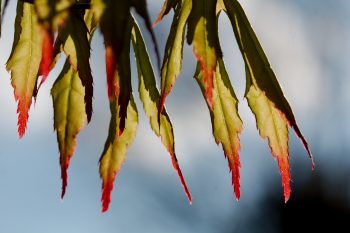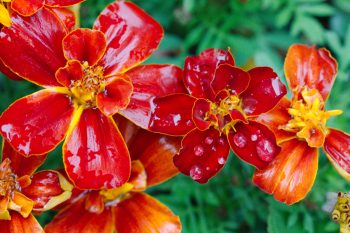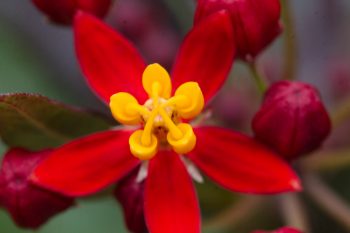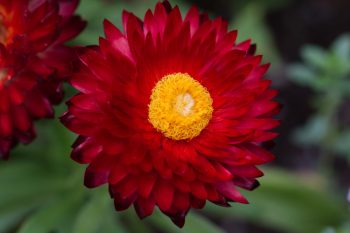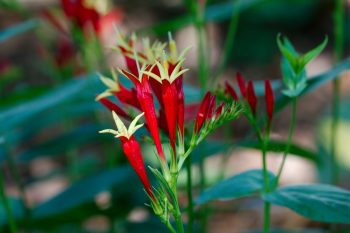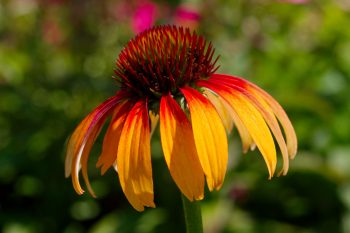This red Lobelia cardinalis is growing under the cherry tree at the north end of our yard. It’s really bright and I thought it was worth getting a picture of. With my back still bothering me I wanted to be really careful getting behind it so I could get the picture without having to bend over and with the trunk of the cherry tree available for me to brace the camera against. I was very carefully watching where I was stepping so I wouldn’t trip but about half way back, all of a sudden, I whacked my head against a ceramic wren nesting box hanging from a branch of the tree. I didn’t quite fall but it did my back no favors. Still, I got the picture. Coming back out I was even more careful where I walked and I kept an eye on that nesting box.
Tagged With: Red
Lobelia cardinalis
Staghorn Sumac (Rhus typhina)
I had hoped to get outside yesterday but didn’t. Today I did, walking up the road and onto the empty lot next to my building. The vernal drainage pool is nearly dry. The small areas with water are interesting because there is something in the water that’s not happy to be quite so crowded. If it rains soon, they may be saved. The fall color has only just started to be in evidence but a few things tend to turn early and they stand out. This staghorn sumac (Rhus typhina) is an example. They are also crowned with their bright red, annual, pyramidal fruiting clusters.
Fragaria virginiana (Wild Strawberry)
I only took a few photos today, all in the back yard. Most of them were of the maple leaves that are starting to turn red, but really they have only just started and it’s premature to have fall-color photos. This is a wild strawberry (Fragaria virginiana, also known as scarlet strawberry) growing and fruiting in the yard. This is a native herbaceous perennial and in the description on the Missouri Botanical Garden’s PlantFinder web site, it says they “spread indefinitely by runners that root as they sprawl along the ground.” They aren’t kidding. These will take over a yard. Also, “Cultivated strawberries found in stores are hybrid crosses between F. virginiana (native to North America) and F. chiloensis (native to western coastal South America including Chile) which combine the excellent taste of the former with the larger fruit size of the latter.”
Dogwood
The dogwood in front of our house is in full fall color. It’s not really a good place for a tree, much too close to the house. I’ve planted a camellia near it that, if it survives, will replace it. Last winter was tough on it and all but one small branch near the base died. If it makes it through this winter it will have a chance but I guess we’ll see. If I can get a replacement growing, I’ll cut the dogwood out, but until then, I enjoy the flowers in the spring and the red leaves in the autumn.
Maple
Like the dogwood from yesterday’s photo, this maple tree in our back yard is turning for fall. It’s ahead of most of the trees around, which are predominantly green still. It won’t be long before the rest have changed but it’s been so dry lately that I’m not sure the colors will be as good this year as some. We also may miss a bit of it, but we’ll be in a pretty place for a few days, so won’t mind too much. I guess you’ll just have to wait and see.
Crab Apples
There are a pair of sweet gum trees (Liquidambar styraciflua) a little before I get to work and I stopped today to take pictures of their leaves. Sweet gum generally has some of the best fall color around but I think it’s just a little early so they weren’t as good as they have been in past years. I’ll probably check again in a while. Before I got back in my car and headed the rest of the way to work I took a few pictures of the crab apples nearby. I think they look pretty good against the blue of the sky.
Winter’s First Snow
We had our first snow of the winter overnight. It wasn’t anything that was going to snarl traffic, melting on roadways and not amounting to more than a thin covering on the grass, but it was snow. Early morning after a snow is often quite pretty, especially if the clouds that brought the snow have cleared and it’s sunny. That was the case today. I took a few pictures in the front yard, including this one of the holly near our driveway. The robins generally come at some point in the winter and devour all the berries from this tree. They congregated in another holly a couple days ago and have pretty much stripped that one.
Bramble Thorns
I went out into the empty lot next door to my office this afternoon. It was a cool, breezy, but sunny day and it was really nice to be outside. Before going next door, I walked down to the pond between my building and the next, on the other side from the empty lot, and I took a few pictures of reflections on the water, but they aren’t really anything to speak of. In the empty lot, I took some pictures of sycamore (Platanus occidentalis) leaves with the sun shining strongly on them. They have a lovely texture and color. In the end, though, I decided to go with these bramble thorns. The genus Rubus contains the blackberries, raspberries, and all the related species. In addition to their generally wonderful fruits, they often have pretty stems, leaves, and thorns.
Ranunculus asiaticus
While she was in Alaska from July to December, Dorothy got a job at a florist shop. She’s been exposed to flowers and plants to one degree or another all her life, having been dragged to various botanical gardens and arboreta. More recently she has come to appreciate them more than she did as a child. Nevertheless, her time at the florist has served to increase her love of flowers. This is a Ranunculus asiaticus, the Persian buttercup, and Dorothy brought home a bouquet of them for the dining room table. They are quite beautiful and I love the many overlapping petals of the deep crimson blooms.
Ranunculus
The Ranunculus that I photographed on January 17 continues to deliver. The flowers have opened up and are bright orangy-red with interesting centers. In another day or two they’ll be finished, I think, but we’ll get a little more enjoyment out of them. This time of year, flowers on the table are a nice extravagance. It’s actually getting a bit warm for this time of year and the forecast is for warmer still for a little while. I have no doubt that winter will return before long, though, and we’ll want to stay indoors.
Winter Colors
Around here, winter colors are mostly browns and greys. The sky is often still blue, of course. Lawns and evergreen trees and shrubs are still green. But walking through the woods, which are mostly deciduous, brown and grey predominates. There is still color to be found, if you’re willing to look. We have a number of things that are various shades of burgundy right now. These epimedium leaves are lovely. They are only semi-evergreen, so some have fallen off, but those that remain are really nice. We also have a Lenten rose (Helleborus species) blooming and it has deep purple-red flowers that are wonderful. There are sedums in the front whose leaves and stems turn this color in the winter, as well. So get out there and look down. The color is there waiting to be found.
Amaryllis
We have two amaryllis bulbs from last year that we pretty much neglected after they finished blooming. They had leaves for a while but we stopped watering them and they just sat on shelves in the kitchen after that. They normally bloom around Christmas time, which is lovely, of course, but we weren’t paying them any attention. A week ago I notice this one had sent up a shoot with a bud on top so it got a little water. It has rewarded our neglect with two lovely blooms. It now has a spot on the kitchen counter. I had to add two stakes to hold it up because the flowers are pretty heavy and the pot it’s in is not.
Dried Amaryllis Flower
This is the same amaryllis flower that I posted a photo of a week an a half ago (see Thursday, March 12, 2020). As you can see, it’s dried out but interestingly has retained some of it’s color. Since taking this photo, I’ve cut the stem so we won’t get any seeds. They are so easily available in bulb form late in the year that we buy one most years. This one came back into bloom, a little later than expected but without much of any attention having been paid to it in the meantime.
Daffodil ‘Actaea’
This is a daffodil called ‘Actaea’, which is in the poeticus division (division 9), which are distinguished by their large white petals and small, dainty cups in contrasting colors. I think they are fairly posh, compared to their more boisterous cousins but they are similar in their hardiness. They are a bit slower to produce large clumps, though, so if you want a lot of them in a hurry, you’ll want to plant more of them up front. The stems on these are a little less rigid than the others, as well, and they have a tendency to droop even more when it rains but in the sun, they are hard to beat.
Maple Leaves
I had a photo of dogwood leaves coming out of their buds recently (see Thursday, April 09, 2020) and they were pretty well liked on Instagram. That tree is a volunteer seedling that has been growing in a large bed in our back yard there there was once a large silver maple tree. That bed has been left pretty much to itself for quite a few years although we starting taking it back last summer and will do more this year. Along with the flowering dogwood (Cornus florida) there is a small maple seedling coming up. It’s close enough to the dogwood that we cannot really keep them both, but before I cut it out, I thought I’d post a photo of the new leaves coming out on it. It appears to have Japanese maple (Acer palmatum) in it’s makeup. But it’s going. Sorry.
Marigold ‘Durango Red’
As mentioned on Sunday, we went to the garden center to buy plants for Cathy to put in containers and into the ground for the summer. These were mostly annuals, although we did buy a few perennials, as well, including a rosemary. This is one of the marigolds that Cathy picked out. It’s called ‘Durango Red’ and it’s a really nice, burnt orange color. It’s especially nice in the rain, which was heavy today. This is out on the driveway right now but it will probably go into the ground before too long. They are a quick and easy way to get a lot of color in your garden.
Asclepias curassavica ‘Silky Red’
One of the plants Cathy bought on our annual Mother’s Day trip to the nursery (a week early this year) was this blood flower, Asclepias curassavica ‘Silky Red’. As you can see, the colors are pretty intense. This species of butterfly weed is native to the Caribbean and Central and South America and is only winter hardy to USDA zones 9 to 11, so we grow it as an annual here but it’s worth it. The butterflies and other insects love it and even without that, it’s just a beautiful flower. If you have a very bright indoor location (or a heated greenhouse!) then you could bring it in for the winter, but we just start new each year.
Red Strawflower
We’ve had strawflower (Xerochrysum bracteatum) each of the last few years and I really like it quite a lot. Also known as everlasting flower, it provides color over a really long period. The central part of the flower turns dark but the almost woody bracts keep their color. This year, we happened to come across this bright red variety. I have to say, it’s really a stunner. The yellow one is nice, but this one is just amazing. I think maybe next year I’ll get more than one. I don’t know that I could get tired of this color.
Spigelia marilandica (Indian Pink)
Here’s a second photo for the day. After our walk in the park, we went to the Agricultural Farm Park and walked through their demonstration garden. It’s really changed since we were here last, about two months ago. There was one plant in bloom that really caught our collective eye. It’s a Maryland native commonly called Indian pink (Spigelia marilandica). What a beautiful flower. This is something I’d really like to get. I’ve done some searching and it seems like finding seeds will be difficult. There are a few mail order places that have the plant but most of them ship in the fall. Hopefully I’ll remember to order some then.
‘Fiery Meadow Mama’ Coneflower
I could see a fairly large garden with nothing but varieties of coneflower (Echinacea species and varieties). One problem we have with them is that the rabbits and deer seem to like them and many that come up have their flowering stem bitten off so we don’t get flowers on them. The few that do bloom are great, of course, but then th bugs get to them and the petals get holes in them. They’re still nice, but not as photogenic. Because of that, we hesitate to buy more coneflowers. This one, called ‘Fiery Meadow Mama’, nearly made me make an exception. Wow, what a flower. There was another called ‘Cone-fections Hot Papaya’ that was mostly red and with a larger center that was nice, too. But we restrained ourselves.


